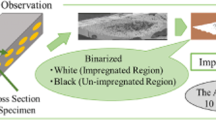Abstract
Through the combination of Reynolds equation and Darcy’s law, a mathematical model was established to calculate the pressure distribution in wedge area, which contributed to the forecast effect of processing parameters on impregnation degree of the fiber bundle. The experiments were conducted to verify the capacity of the proposed model with satisfactory results, which means that the model is effective in predicting the influence of processing parameters on impregnation. From the mathematical model, it was known that the impregnation degree of the fiber bundle would be improved by increasing the processing temperature, number and radius of pins, or decreasing the pulling speed and the center distance of pins, which provided a possible solution to the difficulty of melt with high viscosity in melt impregnation and optimization of impregnation processing.















Similar content being viewed by others
References
Fang X., Shen C., Dai G.: Mechanical properties of unidirectional continuous fiber tapes reinforced long fiber thermoplastics and their manufacturing. J. Reinf. Plast. Compos. 35(5), 408–420 (2016)
Gabrion X., Placet V., Trivaudey F., Boubakar L.: About the thermomechanical behavior of a carbon fibre reinforced high-temperature thermoplastic composite. Compos. Part B-Eng. 95, 386–394 (2016)
Bohm R., Hufnagl E., Kupfer R., Engler T., Hausding J., Cherif C., Hufenbach W.: Thermoplastic composites reinforced with textile grids: development of a manufacturing chain and experimental characterization. Appl. Compos. Mater. 20(6), 1077–1096 (2013)
Karaduman Y., Onal L., Rawal A.: Effect of stacking sequence on mechanical properties of hybrid flax/jute fibers reinforced thermoplastic composites. Polym. Compos. 36(12), 2167–2173 (2015)
Risicato J., Kelly F., Soulat D., Legrand X., Trumper W., Cochrane C., Koncar V.: A complex shaped reinforced thermoplastic composite part made of commingled yarns with integrated sensor. Appl. Compos. Mater. 22(1), 81–98 (2015)
Hasselbruch H., Von Hehl A., Zoch H.W.: Properties and failure behavior of hybrid wire mesh/carbon fiber reinforced thermoplastic composites under quasi-static tensile load. Mater. Design. 66, 429–436 (2015)
Vaidya U.K., Chawla K.K.: Processing of fibre reinforced thermoplastic composites. Int. Mater. Rev. 53(4), 185–218 (2008)
Steggall-Murphy C., Simacke P., Advani S.G., Yarlagdda S., Walsh S.: A model for thermoplastic melt impregnation of fiber bundles during consolidation of powder-impregnated continuous fiber composites. Compos. Part A-Appl. S. 41(1), 93–100 (2010)
Xian G., Pu H.T., Yi X.S., Pan Y.: Parametric optimization of pin-assisted-melt impregnation of glass fiber/polypropylene by taguchi method. J. Compos. Mater. 40(23), 2087–2097 (2006)
Kim J.W., Lee J.S.: The effect of the melt viscosity and impregnation of a film on the mechanical properties of thermoplastic composites. Materials. 9(6), 448 (2016)
Carlone P., Palazzo G.S.: Unsaturated and saturated flow front tracking in liquid composite molding processes using dielectric sensors. Appl. Compos. Mater. 22(5), 543–557 (2015)
Vlug M.A.: Shell Research Limited: Process of melt impregnation. US, 5798068. (1998)
Xian G., Pu H.T., Yi X.S., Pan Y.: Parametric optimization of pin-assisted-melt impregnation of glass fiber/propylene by taguchi method. J. Compos. Mater. 40(23), 2087–2097 (2006)
Stavrov V.P., Starvrov V.V., Pankova N.V., Friedrich K.: Variation of the structure and permeability of tensioned fiber layers during impregnation with a thermoplastic polymer melt. Mech. Compos. Mater. 36(2), 155–162 (2000)
Bates P.J., Kendall J., Taylor D., Cunningham M.: Pressure build-up during melt impregnation. Compos. Sci. Technol. 62(3), 379–384 (2002)
Chandler H.W., Devlin B.J., Gibson A.G.: A model for the continuous impregnation of fiber tows in resin baths with pins. Plast. Rub. Compos. Pro. 18(4), 215–220 (1992)
Seo J.W., Lee W.I.: A model of the resin impregnation in thermoplastic composites. J. Compos. Mater. 25(9), 1127–1142 (1991)
Koubaa S., Burtin C., Poitou A., Lecorre S.: Simple modelling of impregnation in pultrusion process of thermoplastic composites. Int. J. Microstruct. Mater. Prop. 7(5), 428–438 (2012)
Peltonen P., Lahteenkorva K., Paakkonen E.J., Jarvela P.K., Tormala P.: The influence of melt impregnation parameters on the degree of impregnation of a polypropylene/glass fibre prepreg. J. Thermoplast. Compos. 5(4), 318–343 (1992)
Bates P.J., Zou X.P.: Polymer melt impregnation of glass roving: modeling and experimental. Int. Polym. Process. 17(4), 376–386 (2002)
Bates P.J., Charrier J.M.: Pulling tension monitoring during the melt impregnation of glass roving. Polym. Compos. 21(1), 104–113 (2000)
Polychronopoulos N.D., Papathanasiou T.D.: Pin-assisted resin infiltration of porous substrates. Compos. Part A-Appl. S. 71, 126–135 (2015)
Acknowledgments
This work was supported by the National Natural Science Foundation of China (Grant No. 51273019) and our industry partner Nanjing Chuangbo Machinery Co. Ltd. The authors would also like to appreciate for the assistances from Prof. Qingchun Li and Mr. Jufa Guo in the experimental testing.
Author information
Authors and Affiliations
Corresponding authors
Rights and permissions
About this article
Cite this article
Ren, F., Yu, Y., Yang, J. et al. A Mathematical Model for Continuous Fiber Reinforced Thermoplastic Composite in Melt Impregnation. Appl Compos Mater 24, 675–690 (2017). https://doi.org/10.1007/s10443-016-9534-z
Received:
Accepted:
Published:
Issue Date:
DOI: https://doi.org/10.1007/s10443-016-9534-z




